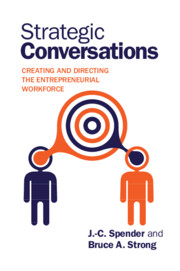Book contents
- Frontmatter
- Contents
- List of figures
- List of tables
- Acknowledgements
- Preface
- 1 Introduction – what are strategic conversations?
- 2 The strategic conversations imperative
- 3 Strategic conversations in the wild
- 4 Engaging employees in management’s agenda
- 5 Strategizing and the leaders’ role
- 6 Putting strategic conversations into practice – innovation communities
- 7 Conversation trumps structure – new norms for dialog
- 8 Strategic conversations across geographies, generations, and the multitude
- 9 Engaging the world outside in the conversation
- 10 Creating a self-reinforcing innovation platform – collateral benefits
- 11 Measuring the future
- 12 Epilogue – on managing
- Further reading
- Notes
- Index
1 - Introduction – what are strategic conversations?
Published online by Cambridge University Press: 05 June 2014
- Frontmatter
- Contents
- List of figures
- List of tables
- Acknowledgements
- Preface
- 1 Introduction – what are strategic conversations?
- 2 The strategic conversations imperative
- 3 Strategic conversations in the wild
- 4 Engaging employees in management’s agenda
- 5 Strategizing and the leaders’ role
- 6 Putting strategic conversations into practice – innovation communities
- 7 Conversation trumps structure – new norms for dialog
- 8 Strategic conversations across geographies, generations, and the multitude
- 9 Engaging the world outside in the conversation
- 10 Creating a self-reinforcing innovation platform – collateral benefits
- 11 Measuring the future
- 12 Epilogue – on managing
- Further reading
- Notes
- Index
Summary
A great part of the machines . . . were originally the invention of common workmen, who, being each of them employed in some very simple operation, naturally turned their thoughts towards finding out easier and readier methods of performing it. Whoever has been much accustomed to visit such manufactures, must frequently have been shewn very pretty machines, which were the inventions of such workmen, in order to facilitate and quicken their own particular part of the work.
Adam Smith, Wealth of nationsMany organizations are sitting on an untapped mother lode of sustainable competitive advantage and don’t know it. We’re talking about a massive amount of energy and imagination, informed by deep industry knowledge. It has the potential to help companies keep their business models fresh and vital. It’s already paid for, but rarely deployed.
Where is this rich vein of untapped value? Right at hand, begging to be used: it’s the business’ own people. Many studies show employees want to make a difference. They are eager to use their talents, domain knowledge, and energy to help grow their organizations. Too often, however, this potential is buried by management practices that stifle employee enthusiasm. Peter Drucker put it well, “So much of what we call management consists of making it difficult for people to work.” Most companies don’t know how to ask employees to think about making the business stronger, don’t have the processes to channel this energy, and don’t know how to recognize and reward it. But just like Adam Smith’s pin factory workers, today’s employees have what Clay Shirky calls “cognitive surplus,” time and mental space not tied directly to their day-to-day work lives. This uncommitted employee energy and imagination is available to the organizations, if only they knew how to harness it.
- Type
- Chapter
- Information
- Strategic ConversationsCreating and Directing the Entrepreneurial Workforce, pp. 1 - 6Publisher: Cambridge University PressPrint publication year: 2014
- 1
- Cited by



